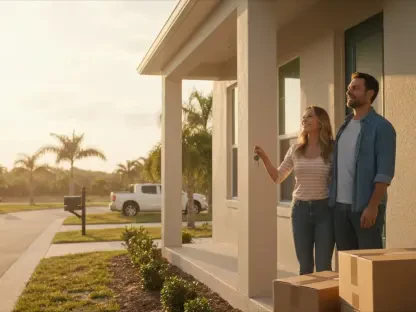Washington State has taken a pivotal step toward addressing housing affordability through the enactment of House Bill 1217. This legislation seeks to cap rent increases, transforming housing market dynamics across the state. The bill aims to alleviate the burden on renters amid surging living costs while also setting the stage for potential conflict between various stakeholders. Analyzing the nuances of this legislation and its broader implications reveals a complex landscape where tenant protections, legislative hurdles, and future housing developments intersect.
Legislative Measures for Rent Control
Introduction to House Bill 1217
House Bill 1217 marks a significant shift in rent control policy within Washington State, setting restrictions on annual rent hikes to 7% plus inflation, with a hard cap at 10%. This measure is designed to offer renters a sense of stability and predictability in a region where living expenses are notoriously high. By instituting these limits, the legislation seeks to protect tenants from being priced out of their homes due to exorbitant rent increases, aiming to make housing more sustainable for a larger segment of the population over the coming years.
This measure reflects policymakers’ efforts to strike a balance between protecting tenants and ensuring that property owners remain incentivized to maintain rental units. Given the law’s comprehensive nature, it encompasses various types of housing, including restrictions specifically designed for manufactured homes. For this category, rent increases are capped at 5%, with an indefinite duration for this stipulation. By limiting rent increases, the legislation hopes to mitigate financial strain on renters, fostering a more equitable housing landscape.
Focus on Tenant Protection
The primary objective of House Bill 1217 is to safeguard tenants from unpredictable rent hikes, which can significantly disrupt financial stability. In a metropolitan environment where housing costs are on the rise, this cap offers a pathway to more manageable living expenses. The strategy behind these measures recognizes the statewide issue of housing affordability and the pressing need to implement safeguards that protect vulnerable population groups from exploitative pricing practices that have become increasingly common.
Moreover, specific provisions within the legislation address exemptions, allowing landlords a degree of flexibility while ensuring that the primary intent of the bill remains intact. For example, initial lease agreements are protected from rent hikes in the first year, providing tenants with crucial stability as they enter into new rental contracts. New constructions, on the other hand, benefit from a 12-year exemption from the caps, reflecting an effort to encourage development by not penalizing emerging property investments. This nuanced approach acknowledges the diverse needs of both tenants and property developers.
The Legislative Journey
Challenges in Lawmaking
The path to enacting House Bill 1217 was neither straightforward nor without debate, reflecting the complexity of achieving consensus on housing regulation. The legislative process exposed divisions within ranks, particularly among progressive and moderate Democrats, each advocating nuanced positions regarding rent control caps. As discussions unfolded in legislative chambers, key adjustments were made, notably the Senate’s role in raising the proposed cap. These shifts highlighted the intricate negotiations essential to advancing such a measure through a daunting legislative labyrinth.
This legislative journey underscored the intricacies of balancing stakeholder interests, drawing attention to the ways varying political ideologies shape housing policy. Negotiations necessitated considerable compromise as lawmakers worked to reconcile different visions for how best to address the affordability crisis. The resulting law represents a carefully negotiated agreement reflecting both progressive aims to curtail exploitative rent increases and a recognition of practical limitations in implementing universal measures. This legislative milestone represents a pivotal juncture in Washington’s approach to housing policy.
Exemptions and Initial Lease Terms
House Bill 1217 includes a range of exemptions offering landlords flexibility while adhering to its tenant protection goals. One prominent exemption is the prohibition of rent increases during a tenant’s first year of occupancy, ensuring an initial stabilization period. This provision is vital in maintaining tenant confidence and allows them to plan their finances without the immediate concern of escalating rents. Public housing units get notable exemptions as well, with specific cap exemptions applied across numerous housing situations, such as multi-unit properties with onsite owners.
The legislation also extends exemptions to new constructions, which are not subject to the caps for their first 12 years. In doing so, it seeks to stimulate housing development by removing potential restrictions on rental income for newer properties. These exemptions signify balanced policy consideration, attempting to drive both housing growth and tenant security. Simultaneously, strict enforcement measures involve requiring landlords to notify tenants 90 days prior to any allowed rent hike, with penalties for non-compliance, reinforcing the protective intent embedded in the law’s framework.
Navigating the Impacts
Proponents Versus Critics
Support for House Bill 1217 emerges predominantly from Democratic quarters, with proponents arguing the necessity of controlling excessive rent increases to provide economic relief to a swelled rental market. Advocates, including Governor Bob Ferguson, assert the legislation as a critical tool to shield low-income families from the threat of displacement, which threatens community fabric when residents face untenable living costs. In light of increasing pressures on housing, supporters consider the rent cap an essential mechanism in stymieing an unbounded market prone to vast disparities.
Conversely, the bill has attracted criticism from Republicans and housing industry stakeholders who express concerns regarding potential negative repercussions. Critics fear the legislative impositions could deter housing investments, pressure landlords into property sales, or result in accommodation quality drops as proprietors grapple with imposed limits amid rising maintenance costs and property taxes. Organizations such as the Rental Housing Association of Washington contemplate legal challenges, particularly scrutinizing the bill’s emergency provision granting it immediate enactment.
Legal Challenges and Industry Concerns
The implementation of House Bill 1217 is not devoid of legal contention, as industry groups express intentions to challenge the bill through judicial channels. Key concerns include the emergency clause that hastened the law’s introduction without allowances for adequate deliberations over inflation rate allowances—which landlords argue are crucial considerations in light of volatile economic conditions. The conflict between maintaining an affordable housing market and sustaining developments emerges, signaling tensions over how best to balance these sometimes contradictory objectives.
Landlords articulate anxieties regarding the feasibility of abiding by the restrictive rent caps when juxtaposed with escalating upkeep expenses and tax obligations. These concerns point to a potential impaction on the broader housing economy, suggesting that the restrictive elements could inadvertently thwart market growth, reduce available housing stock, and foster longer-term shortages. As such, the bill’s broader impacts resonate within both governmental and industry circles, necessitating ongoing discourse regarding optimal implementations and modifications to realize balanced housing strategies.
Broader Housing Initiatives
Complementary Legislation
House Bill 1217 stands as but one piece of Governor Bob Ferguson’s larger housing agenda aimed at addressing affordability through an integrated legislative suite. Coupled with the rent cap, complementary measures have been enacted to encourage housing development and investment. Efforts to dismantle barriers to construction and spur urban development serve as vital facets of holistic attempts to overhaul the affordability landscape, addressing pressures from both market and governmental perspectives.
This legislative framework encompasses bills designed to promote efficient utilization of land and resources while fostering environments conducive to construction. Specific provisions facilitate redevelopment and seek to expand homeownership opportunities—a reflection of the understanding that a multifaceted approach is requisite to effectively tackle the housing conundrum. Such initiatives underscore the legislature’s resolve to bridge the divide between pressing housing needs and sustainable urban growth, crafting policies that cater to both renter and developer interests alike.
Urban Development Encouragement
Washington State is making a significant move to tackle housing affordability by enacting House Bill 1217. This new legislation is designed to put a limit on rent increases, reshaping the housing market dynamics throughout the state. By setting these limits, the bill aims to ease the financial strain on renters who face rising living costs. However, it also introduces potential challenges by setting the stage for disagreement among various stakeholders, including landlords, renters, and policymakers. The complexity of this legislation lies in balancing tenant protections with market realities, considering the legislative hurdles and its consequences for future housing developments. As Washington steps forward with its housing agenda, observers are keenly watching how this bill will unfold, potentially setting a precedent for other states grappling with affordability issues. With competing interests at play, the impacts of this legislative effort are both promising and subject to intense debate.









